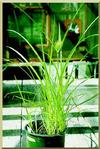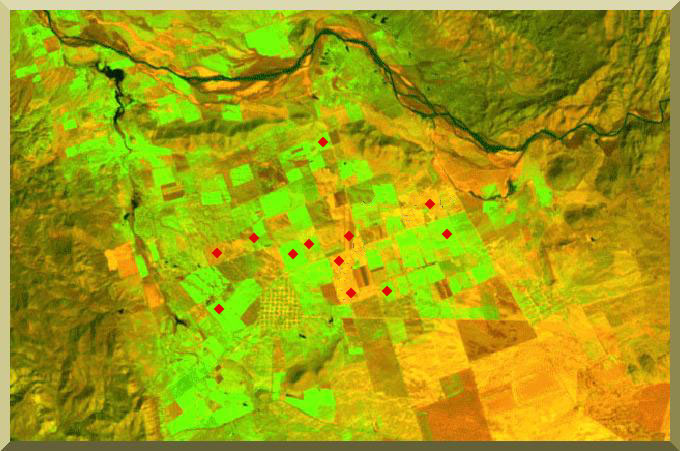|
|
|
|
| 6. STRATEGIES FOR THE OJOS NEGROS VALLEY |
|
6.1 Botanical Description
The botanical description corresponds to the species Cyperus esculentus collected in the valleys of Ojos Negros, Maneadero and La Trinidad. The description of Cyperus rotundus is not included because the field samples did not show differences, being all Cyperus esculentus. The genus Cyperus esculentus is an annual or perennial with flowers of various arrangements, frequently in compound inflorescences sustained by bracts resembling leaves. Its plants generally have rizomes, the plants are not dioic (with both sexes in the same plant), perfect flowers, stems generally rooted from the base of the inflorescence, even though in contact with the soil; rizomes with presence of tubers, fruits of 1.5 to 1.8 mm of length, of brown-grayish color, shiny; thin scales, reddish, acute; the tubers of more than 1 cm diameter. The height of this plant in the region is from 30 to 60 cm. Yellow nutsedge is found close to arroyos and channels, and its flowering is from June to October. In the northwestern region of Baja California, it is known as "coquillo," which competes with high-yield irrigated crops. It is considered a weed, and is subject to control with herbicides with little success. 6.2 Affected Producers The following table shows a list of agricultural producers (ejidatarios) in the Ojos Negros valley, whose parcels are affected with the coquillo weed.
6.3 Field Observations The following observations have been made after several field inspections:
6.4 Bromatological Analysis A sample of Cyperus esculentus was taken to the UABC Laboratory of Animal Nutrition in Mexicali for a bromatological analysis. The results are shown in the following table.
6.5 Control Strategies The research has determined that the coquillo is a weed that thrives in irrigated lands such as those of the Ojos Negros valley, in sandy soils, and that it is a crop which is difficult to kill by mechanical or chemical means. The research has also revealed a potential for a positive use of the coquillo tubers as food for animals and humans. The tubers have been effectively used as pig feed, and for feeding wildlife such as cranes and wild turkeys. An alternative use of the yellow nutsedge, which holds promise for the Ojos Negros valley, is the marketing of the coquillo tubers for the preparation of the horchata drink ("horchata de chufas"). This will require a change in the local attitude toward coquillo, from a weed to a beneficial plant. Research is needed to explore the possibility of applying this concept in the Ojos Negros valley, and in neighboring valleys such as the Maneadero valley, near Ensenada, and the Trinidad valley. The extent of the coquillo infestation in these valleys appears to be greater than in the Ojos Negros valley. 6.6 Interviews with Affected Producers
In June 2002, the affected producers (listed in section 6.1) were interviewed to gather their perceptions on the causes, extent, and strategies to deal with the coquillo problem. Thirteen interviews were conducted with owners (ejidatarios) and renters. A summary of the responses is given below.
Most affected producers attribute the presence of coquillo to land or machinery rental; some point out that the coquillo has been brought in with seed mix for pasture. There appears to be a strong link between the presence of coquillo and the cultivation of green onions (cebollin). Propagation is aided by the sharing of equipment and dispersion by animals (birds or groundhogs). Vegetable crops are most affected by coquillo; these include green onions, onions, hot peppers, tomatillo, beans, watermelon, melon, and pumpkin. Among the affected crops, the green onion shows the greatest vulnerability, competing very poorly with the coquillo. Taller and denser crops such as alfalfa, wheat, tall grass and prairie grass are not as vulnerable because they tend to shade the coquillo, inhibiting its growth. Farmers who have rented their fields to the agricultural companies (Agroindustrias Vigor, Estrella Nueva, Agricola el Sol and Agricola el Toro) have reported coquillo infestations in the years following the rental period. The companies are shying away from continuing to rent infested parcels.
The coquillo has been recognized as a problem in the valley for the past 6 years, but some have mentioned longer periods, up to 16 years. Most people interviewed agree that the extent of coquillo infestation has been increasing, while consistently being fought with cultural practices and other means, including mechanical and chemical. In general, the affected producers are not aware of the type of coquillo, although the evidence suggests that the yellow nutsedge predominates over the purple nutsedge. The extent of the infestation varies from moderate to severe, typically ranging from 10% to 30% of aerial coverage. In some fields, the infestation appears in dense patches, while in others it covers most of the field with low density. One particular parcel close to a packing plant was severely infested, with the coquillo seen in patches as well as distributed throughout the land. In two cases the infestation was minimal, being restricted to small areas.
The affected producers have tried to control the coquillo in many ways. Some have used herbicides like Bueno 6, Dual, Gramopol and Sempra, but these herbicides provide a temporary solution and do not eliminate the tuber. The herbicides tend to kill only the aerial part of the coquillo and are expensive and inefficient. Nonetheless, the majority of the producers will keep using this strategy for lack of a better alternative. A solution that has been tried is to rest the field for one year or more in an attempt to kill the tuber. Manual and mechanical removal of the aerial parts is a common way to attack the coquillo, but it increases the cost of operation, reducing profits. Infested parcels are being weeded mechanically to discourage and eliminate competition with the planted crop. A novel approach consists of removing a depth of soil, say 30-50 cm, when the infested area is new and of limited extent; the extracted soil is quarantined and the field is then leveled for cultivation. Little if any support has been forthcoming from the various levels of government to control the coquillo weed.
The use of pigs to dig out and eat the tubers has been recognized, but there are some drawbacks, including the unsanitary conditions and the practicality of the procedure; two of the producers interviewed recognized this alternative as a solution. Solarization is expensive, it has not been tried, and there is no experience with it. The affected producers were suprised when told that the coquillo is grown commercially in other parts of the world. Reactions ranged from positive to negative. A few farmers wholeheartedly supported the concept of growing coquillo as a crop, if further research clarified its feasibility and if the economic benefits could be clearly defined. Other farmers tended to regard the coquillo more as a menace than anything else, and were reluctant to consider it as a crop. More research is recommended on this issue.
|
| General | Yellow Nutsedge | Purple Nutsedge | Comparison |
| Sustainable Control Strategies | Summary | Coquillo Facts |
| http://ponce.sdsu.edu/three_issues_coquillofacts06.html | 021106 |


